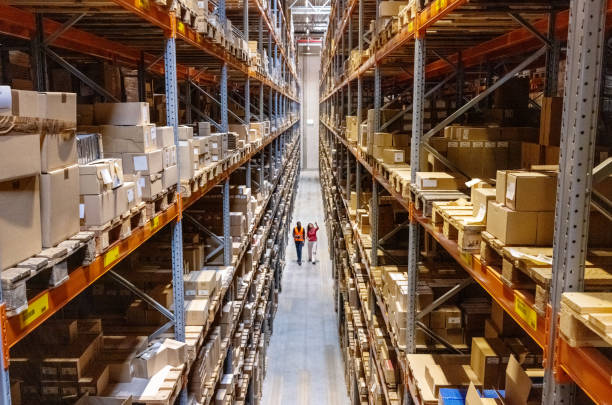2025 is an important turning point in the areas of logistics and online commerce, particularly for fulfillment companies Canada relies on to meet growing demand. Due to increasing expectations from consumers, along with global disruptions and the rise of online shopping across all sectors, Canadian fulfillment providers are changing to address the new demands. Traditional order processing and warehousing have become obsolete. Today, the ability to adapt, innovate, and operate sustainably defines the future of fulfillment in warehouses across Canada.

Smart Warehousing: Technology at the Core
One of the largest trends that are sweeping across the sector of fulfillment is the emergence of smart warehousing and distribution systems. By 2025, fulfillment organizations across Canada will be embracing robots, automation, and artificial intelligence in order to improve efficacy and efficiency.
Key technological advancements include:
- Automated selection and packing: Reduces human error and speeds up delivery times.
- Live inventory monitoring Improves visibility and helps decision-making based on data.
- Artificial Intelligence-driven Forecasting: It helps predict levels of stock as well as seasonal trends. It also helps maximize the use of resources.
This is especially crucial for fulfillment centers in warehouses, because the huge quantity and variety of SKUs could overpower manual systems. This results in a smooth, flexible, responsive and responsive process that is able to serve both the B2C and B2B industries.
Emphasis on Sustainability and Green Logistics
The responsibility to protect the environment is no longer an option. As a response to the demands of regulators as well as consumer demands, Canadian fulfillment companies are making sustainability a part of their activities.
The prominent changes are:
- Moving towards electric-powered delivery cars.
- Utilizing recyclable or biodegradable packaging products.
- Modifying warehouse layouts to increase energy efficiency.
- Solar-powered power plants are being implemented.
The eco-friendly choices do not just reduce carbon footprint, they also connect the brands with customers who are environmentally conscious. By 2025, sustainable logistics will be as important an edge in the marketing world and a moral obligation.
Expanding Beyond E-commerce: Serving Diverse Industries
Although online shopping remains the main source of fulfillment, the companies are expanding their clients. Nowadays, fulfillment firms across Canada expand their services in order to serve different industries like
- Health and pharmacy
- Consumer electronics
- Retail and fashion
- Beverages and food (especially non-perishable foods)
Every industry has their own set of standards. For instance, warehouse fulfillment of healthcare-related products needs rigorous temperature control as well as regulations compliance. With the help of customizing their services service providers are developing more durable and flexible fulfillment networks.
Regional Distribution and Micro-Warehousing
The Canadian geographical area presents a distinct logistical problem: vast territories that have small populations in some areas. In order to overcome this, numerous fulfillment companies have adopted an approach that is decentralized, by opening micro-warehouses, regional distribution centers and even regional warehouses.
Benefits from this model are:
- Faster last-mile delivery.
- Lower shipping cost.
- Customer satisfaction is improved by offering same-day or next-day services.
- Flexibleness during peak demand seasons.
Particularly in the major hubs of Toronto, Vancouver, and Montreal Micro-warehousing has enabled companies to connect with their clients quicker and faster while maximizing transportation routes.

Greater Customization and Value-Added Services
By 2025, fulfillment will not merely be about storage or delivery, but rather offering complete logistic solutions that are tailored to the needs of each customer. Fulfillment businesses across Canada have expanded their service range to include:
- Kitting and assembly
- Subscription box fulfillment
- Returns Management
- Product personalization
- Real-time analytics dashboards
These services add value to the customer satisfaction and assist companies build trust with their customers. Through their role as strategic partners instead of just logistics companies Warehouse fulfillment firms have a larger part in the growth of businesses.
Conclusion: Adaptability is the New Standard
The development of fulfillment businesses in Canada is powered by a blend of environmental and technological responsibility, and evolving marketplace requirements. In 2025, the most profitable businesses are those who prioritize flexibility, provide customized solutions using data, and use it to optimize every element of the fulfillment experience.
Through automated processes, regional distribution or more sustainable methods the landscape is evolving quickly. Fulfillment companies that do not manage to adapt risk being left behind.
FAQs
What’s the most significant problem that fulfillment businesses in Canada have to face in the year 2025?
The biggest problem is keeping up to the rapid pace of changes, both in terms of technology and expectations from consumers. In adjusting to the automation revolution, keeping up with the sustainability requirements, as well as addressing the issue of labor shortages is a top concern.
How has warehouse fulfillment improved in recent years?
The warehouse fulfillment process has become more responsive and intelligent due to robots, IoT devices, and modern software. They provide immediate updates, less rate of error, as well as improved efficiency when processing orders.
Are Canadian fulfillment companies environmentally friendly in 2025?
A number of fulfillment companies are currently striving to make their operations more sustainable. They are implementing initiatives like electric vehicle fleets recycling packaging, as well as green warehouse facilities. But sustainability standards vary among companies.
Why is micro-warehousing becoming popular in Canada?
Micro-warehousing enables speedier, better local deliveries, particularly within urban areas. Additionally, it helps companies decrease the cost of shipping as well as improve the satisfaction of customers.